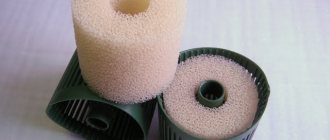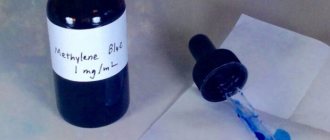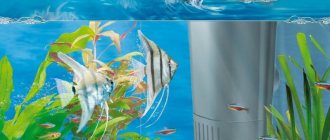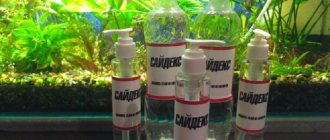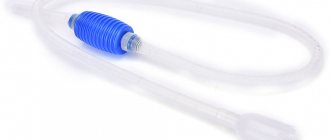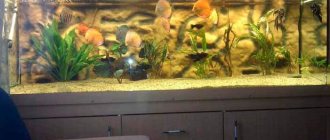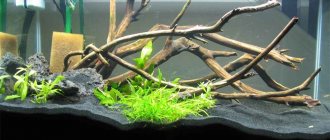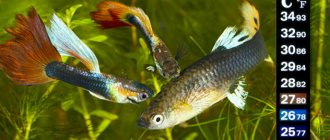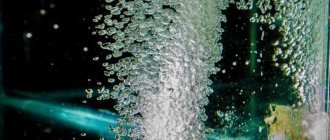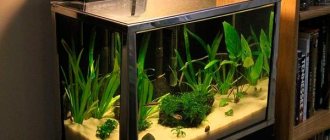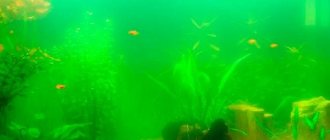Many aquarists pour filtered or boiled water into a new tank with fish, and then wonder why the fish died or got sick. Not everyone knows the golden rule of every aquarist - the liquid must first be settled. Settling is a mandatory measure for tank preparation before startup. The aquatic environment is the main habitat and food for fish. When the water settles, harmful impurities will leave it and the desired temperature will be established. It is important to know how to properly and for how long to settle water for an aquarium.
Why settle water for an aquarium?
Settling is an important stage in preparing a fish tank. It is necessary to settle water for fish to destroy harmful microorganisms, parasites, and heavy metals. Harmful microorganisms feed on fish, so when they settle, they die without finding any food.
The water supply contains a lot of chlorine and iron, which disappear after a few days when settled. When the water sits for several days, it becomes room temperature and is suitable for aquarium fish.
Helping tools
Liquid substances dissolve in water and it is impossible to get rid of them by simple settling. Therefore, aquarists have to use additional means - air conditioners. They are specially designed to improve the composition of water and make it safer for fish.
Tetra Aqua Bactozym
An excellent product that has proven itself to effectively combat nitrites in aquarium water. For this purpose, the drug contains special nitrifying bacteria. The product is often used to clean aquarium water from organic contaminants - it perfectly breaks down food debris, dead plants, fish excrement, etc.
Important! For partial water changes, use 1 capsule per 100 liters. When completely changing the water or after a fish illness, 2 Tetra Aqua Bactozym capsules are required per 100 liters of water.
Aquarium Pharmaceuticals Stress Coat Accu Clear
A unique conditioner for aquarium water that can neutralize heavy metals, chlorine and other harmful substances. The drug contains aloe extract, known for its bactericidal and healing properties. Therefore, it has a beneficial effect on fish, especially after an illness. Use Aquarium Pharmaceuticals Stress Coat Accu Clear according to the instructions.
Aquacons Clean water
A universal product that helps quickly clean an aquarium for any type of contamination. This is organic dirt, massive proliferation of bacteria and harmful chemicals. After using Aquacons Clean Water, aquarium water becomes clear and safe for the inhabitants.
Tetra Aqua CrystalWater
The German manufacturer took care to create the most effective means for cleaning aquarium water. Tetraaqua CrystalWater helps remove various organic contaminants, cloudiness and quickly improve the chemical composition of water. The advantage of the product is that it is absolutely safe for the inhabitants of the aquarium.
The drug binds small particles of impurities, which allows you to subsequently get rid of them through the filter. The product has a special mineral composition, which saturates the water during cleaning. The first changes are noticeable within a few hours. After 12 hours the water becomes absolutely clear.
Is it possible to fill with tap water?
Plumbing is the easiest and cheapest method of obtaining an aquarium aquatic environment. Experts allow tap water to be poured, as it does not harm aquatic life. Before pouring into the tank, the water needs to settle.
If there is a special filter on the tap, the water does not need to settle, but it is still recommended to keep it in the room for a day to set the desired temperature.
If the house does not have a special filter device on the tap, the liquid is allowed to settle for three to four days. During this time, harmful microorganisms will die, chlorine and iron will leave. The water is placed in jars, covered with gauze and waited for 3-4 days. After four days, pour it into the tank and stock the fish. Before use, smell the liquid; if there is chlorine left in it, it will smell sharp. The purified liquid will be transparent, while the liquid contaminated with metals will have a milky tint.
How long should the procedure take at home and how to correctly determine readiness?
With a normal area of contact with air, chlorine disappears 100% in three days , chloramine in a few hours (up to a day).
But for peace of mind, you can use a special aquarium chlorine test - Cl2 Test. These can be drop tests or strip tests.
Experienced aquarists recommend purchasing this test , first of all, in order to check tap water. This will let you know what you have to deal with.
Perhaps there is no chlorine in the water supply, then settling is an unnecessary “dance with tambourines.”
Note! The test will determine the need for settling and will also show whether the settled water is ready for use in the aquarium.
How to settle water for an aquarium
Quality affects the health and life of the inhabitants of the reservoir, so before use it is necessary to settle the water. Preparation for the aquarium plays an important role.
Water suitability must be checked before use. If there is a strong odor or signs of rust are visible, it cannot be used for fish farming. The tank must contain a completely transparent biological environment without any foreign odor.
You cannot use hot water for an aquarium, as it contains more harmful impurities than cold water.
What substances are harmful to fish:
- solid particles settling at the bottom;
- gaseous, volatile substances;
- liquid substances.
When settling, all these substances disappear.
Filtration
Filtration maintains a favorable aquarium environment and is used along with sedimentation. There are three types of filtering:
- biological;
- mechanical;
- chemical
Biological filtration involves purification using beneficial bacteria. With mechanical water passes through the filter material. For chemical cleaning, natural minerals of the zeolite group, ion exchange resins, and peat are used.
Various types of impurities
Particulate matter
When settling, solid particles leave the liquid. Solids come from pipes that delaminate and deteriorate with age. To remove solid impurities, you need to follow simple recommendations:
- pour the liquid into a transparent, preferably glass, container;
- leave for 3-4 hours to settle;
- look after the specified time for the presence of sediment or traces of corrosion;
- in the absence of sediment and rust, settled water can be poured into the aquarium;
- if traces of rust and sediment are found, the liquid is re-poured into a new container and left for several hours.
Cleaning is carried out until the sediment is completely dissolved. The settled liquid can be used in the aquarium.
Gaseous elements
Volatile substances evaporate in the air, and in a humid environment these substances combine with water molecules. To clear the liquid of gaseous substances, it is necessary to settle it for 3-4 days. It is recommended to check the water quality every 10 hours. The disappearance of foreign odor indicates the volatilization of harmful elements.
Soluble substances
The most dangerous elements for fish are soluble ones. These are the hardest elements to get rid of. They do not settle to the bottom and do not evaporate. To clean the liquid from soluble substances, you need to buy special products. They are sold in pet stores. Before purchasing, ask the seller which product is best to take. He will select it according to the type of impurities, type of tank inhabitants, and volume. It is recommended to install a filter mechanism in the fish tank that will remove harmful elements.
What are pH and hardness?
pH is the pH value of an acidic environment. A pH of 7 is considered neutral, as it is more favorable for most aquarium inhabitants. When it is less than 7, the water is alkaline. In order to easily determine the pH of water, you need to purchase litmus papers with a color chart, or specialized aquarium tests.
The second parameter of water is hardness. It is divided into temporary and permanent. Water hardness can also affect aquarium inhabitants. To avoid unpleasant consequences, aquarium water should also be checked for permanent and temporary hardness. It is measured in degrees and calculated by adding temporary and permanent hardness.
In cases where spawning of a certain type of fish is necessary, for example, such as neons, whose eggs can only survive in very soft water, water with a low hardness content is used. However, for most varieties of aquarium fish, water with a hardness content of less than 5 is not suitable for life and reproduction. At the same time, too high water hardness, such as 25 degrees and above, is also detrimental to most aquarium species. Of course, there are exceptions.
The norm is considered to be a hardness of 5 to 25 degrees, which is favorable for the vast majority of different types of aquarium fish.
Aquarists who don't want to bother with different measurements can simply select certain species of fish that thrive in regular tap water.
INVENTORY REQUIRED FOR AQUARIUM.
AERATION IN THE AQUARIUM AND EVERYTHING YOU NEED TO KNOW ABOUT IT.
SPRAYER FOR AQUARIUM AND EVERYTHING YOU NEED TO KNOW ABOUT IT.
Aquarium water: how long to stand
There are different recommendations in the aquarium industry regarding the settling time of water for an aquarium:
- within 10-12 hours;
- in 24 hours;
- at least 7-10 days.
The water supply contains many harmful impurities; you must take into account how long it takes for them to evaporate. It takes time, on average, at least 4 days to get rid of them. During this period, volatile and solid substances disappear. There is no point in letting the aquarium liquid sit longer.
How to properly settle water
When settling liquid, you need to follow certain rules so as not to harm the natural balance.
You cannot change all the fluid in an existing reservoir; the fish will not survive the severe stress and will die. The liquid in the aquarium is changed gradually, 20% of the volume is used for replacement.
If there is no lid on the fish tank, a thin film appears on the surface. It is removed with a piece of paper. The sheet must be placed on the surface and carefully lifted. If the film remains, the procedure is repeated.
Do not add contaminated, untreated water to the aquarium. It must be settled and filtered. Store-bought bottled water is not suitable for an aquarium. This is a “dead” liquid in which there are no microorganisms. It will not benefit aquatic life.
Instructions
You should prepare for changes in advance. To properly prepare the water, you should pay special attention to this issue.
Volume and frequency of replacements
Most aquarists adhere to the classic replacement scheme in aquariums - once a week, 30%.
But it is worth considering that this is a general rule, and each tank has its own nuances:
- For an overclocked herbalist, 30% is not enough. Fans of underwater plants are forced to change up to 50% weekly, this will flush out excess nutrients and prevent an algae outbreak.
- An aquarium with large fish also needs more massive changes, but since the fish can be stressed by fresh water, it is better to do two changes per week at 25-30%, this will reduce the load on the biological system.
- Shrimp tanks are aquariums that require maximum stability of water parameters and stable biological balance, so a weekly change of 10% of the volume will be sufficient.
Preparation of tap H2O
There is a main rule for settling water - the larger the surface in contact with air, the better.
Therefore, you should refuse plastic bottles with a narrow neck . The best option would be buckets, pots and basins.
The fact is that chlorine is a gas, and the larger the surface area of the water, the faster this gas will come out.
Note! Using an aquarium compressor or filter with aeration capability will help speed up this process. Stirring water promotes accelerated gas exchange.
How long should it brew?
Chloramine disappears after just a few hours, chlorine in about three days. Despite the fact that chlorine is rarely used, as a rule, in cases where an outbreak of any infectious or viral diseases is noticed in the region, filtration stations rarely inform people about the decision to use chlorine.
Therefore, to be sure, it is better to leave the water for three days, and even better, blow it with air using an aquarium compressor. Then it will become suitable for use the very next day.
It is almost impossible to determine the readiness of water without using a special aquarium test, because while chlorine has the usual white smell, chloramine does not smell. But it is not necessary to do tests if the water has stood for 2-3 days, since all harmful gases have already evaporated.
Attention! During the coronavirus pandemic, many stations in the Russian Federation are actively chlorinating water.
